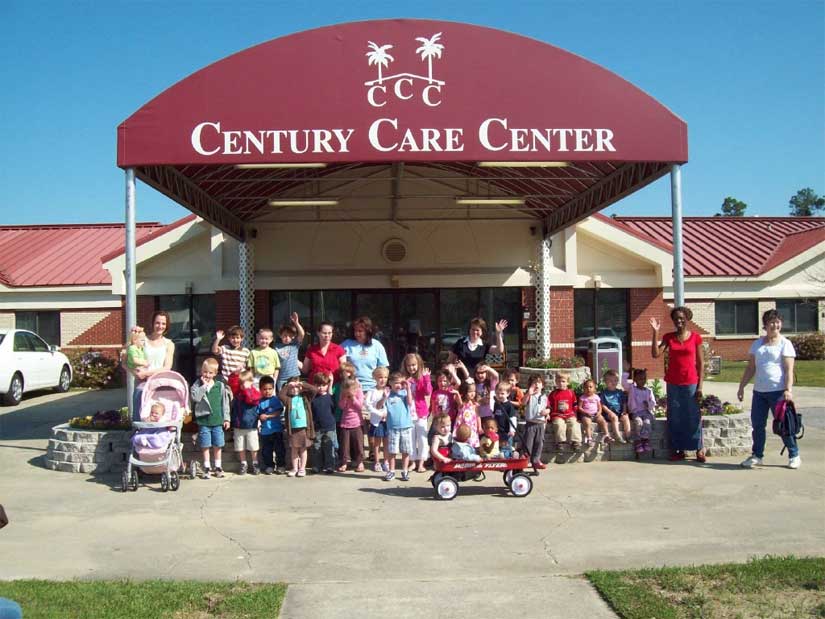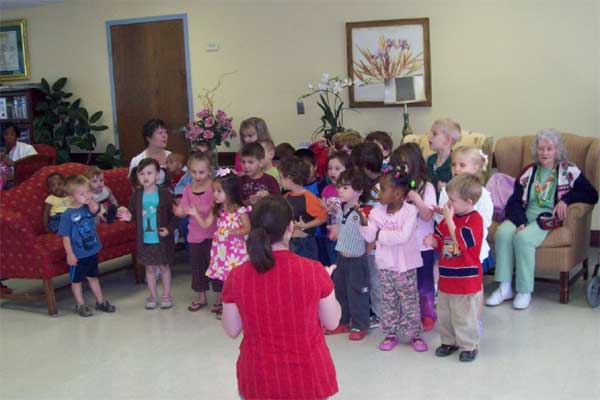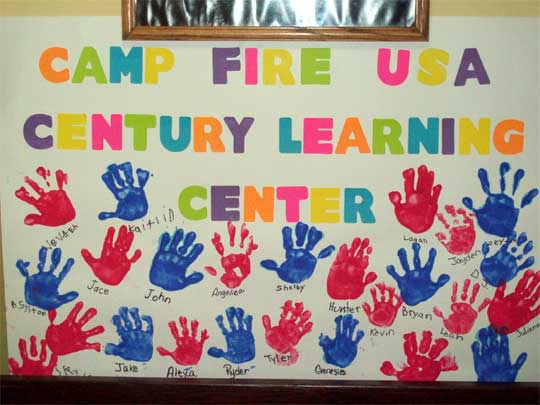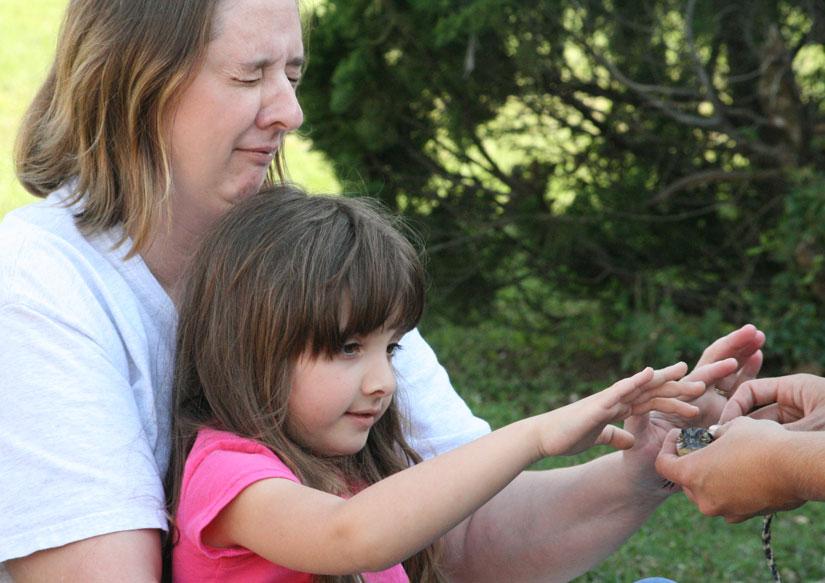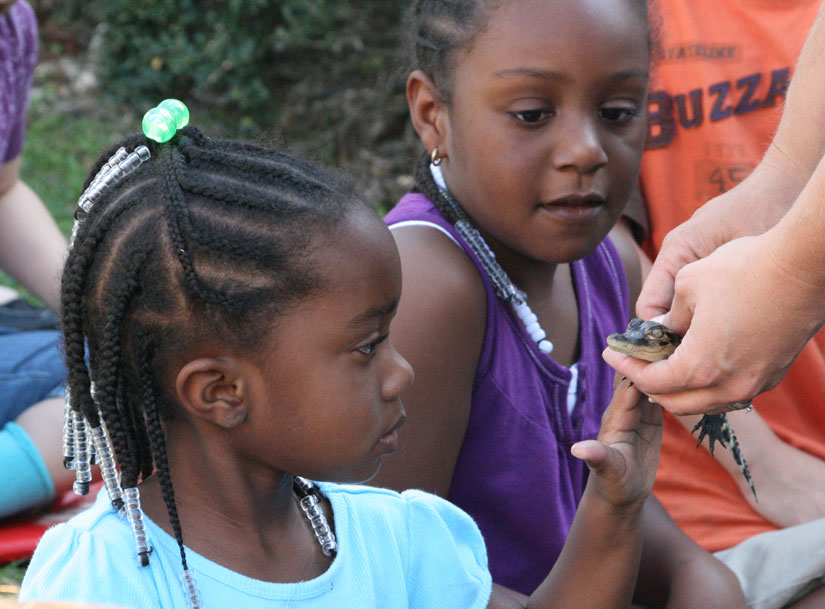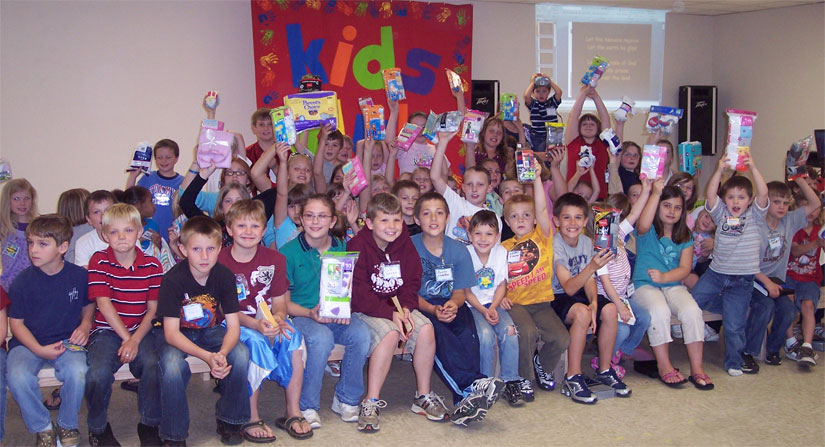What’s Hot: Ernest Ward Middle School’s Newspaper
March 24, 2009
From what’s hot, to what’s not; to the latest news around campus, students at Ernest Ward Middle School turn to the school’s newspaper Through the Eagles Eye.
“It gives us a chance to express our opinions,” Co-editor Anna Donald said. She likes to write stories about FFA and the Ernest Ward Drama Club, because “they are totally me”.
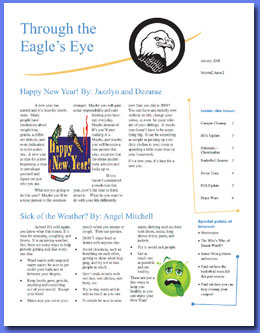 Over the years, the paper had evolved into a publication primarily by teachers with little input from students. Ernest Ward Middle School newspaper sponsor Sara McGinnis has worked to change that.
Over the years, the paper had evolved into a publication primarily by teachers with little input from students. Ernest Ward Middle School newspaper sponsor Sara McGinnis has worked to change that.
“We have returned over the past couple of years to student input. We have good group,” McGinnis said. “Every article is totally done by them, and they sell the paper during lunch.”
“It is more focused, not as random now,” staff member Dezarae Turner said.
Articles are, like at most schools, proofed by school staff to make sure they are appropriate. But McGinnis’ staff said that they work hard to play by the rules.
“We know that when she gives us ‘the look’, it is time to be good,” Donald said.
Turner said she enjoys writing articles about student life. “I like to hear what the student body has to say,” she said.
The students have also learned that in the newspaper business, the right story sells.
“We sell at least 20 extra copies with anything in it that is Twilight related,” Donald said.
(In case you don’t know: Twilight is the movie of 2008 that would be on the “hot” side of the what’s hot, and what’s not list at Ernest Ward or any middle school.)
Click here for a pdf of the January Ernest Ward Middle School newspaper. (This is 591Kb file that may be too large for readers on a dialup internet connection.)
Members of the newspaper staff at Ernest Ward Middle School are: Jazzlyn Franklin, Cheyenne Godwin, Dezarae Turner, Indigo Rodriguez, Jessica Warner, Isaac Dukes, Hannah Fiellin, Jeremy Stacey, Anna Donald and Angel Mitchell.
Pictured top: Ernest Ward Middle School students (L-R) Dezarae Turner, Jeremy Stacy and Anna Donald proofread the latest issue of the school’s newspaper. NorthEscambia.com photo, click to enlarge.
Panhandle Fresh: Group Markets Local Produce
March 23, 2009
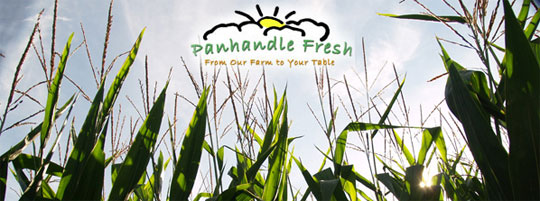
The watermelon and the sweet corn you buy at Wal-Mart late this spring or during the summer may just be from North Escambia. Or the peanuts, or the peppers, or one of the many crops that the marketing cooperative Panhandle Fresh helps local farmers market to the world’s largest retailer.
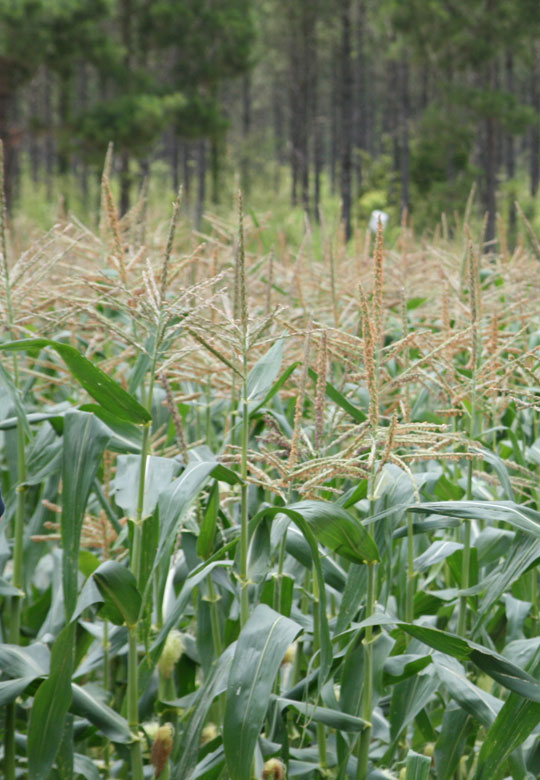 “I never thought I would be selling my sweet corn in Wal-Mart,” Walnut Hill farmer Steve Hiebert told NorthEscambia.com.
“I never thought I would be selling my sweet corn in Wal-Mart,” Walnut Hill farmer Steve Hiebert told NorthEscambia.com.
Panhandle Fresh handles the marketing, the insurance and logistics of getting produce like Steve’s Sweet Corn from Walnut Hill to Wal-Mart. Panhandle Fresh secures the orders from Wal-Mart and works with local farmers to get coordinate the produce delivery.
“We really just work between the farmers and Wal-Mart to sell what is on the land,” said Andrea Sutrick, marketing coordinator from Panhandle Fresh. Sutrick recently joined Panhandle Fresh after working for Kraft Foods for 10 years to secure shelf space for Kraft products.
“This year we hope to ramp it up a little bit and experiment with more production,” Sutrick said.
No matter the scale, Panhandle Fresh Executive Director Cindy Anderson said selling to a giant retailer is very different for most farmers than selling on their farms or at curbside markets.
“This isn’t for everbody,” Anderson said. “We encourage farmers to commit just 20 percent of their crops to the Panhandle Fresh program. This gives us and the producers a chance to figure out how to best make the program work. I’d rather walk before we run.”
 Panhandle Fresh sits between the farmer and Wal-Mart, providing the $3 million in liability insurance that Wal-Mart requires. The group also provides the marketing, works to secure shelf space for the products, takes care of most paperwork and bills Wal-Mart for the produce. The farmer delivers his goods, bills Panhandle Fresh and receives a check for the fresh goods.
Panhandle Fresh sits between the farmer and Wal-Mart, providing the $3 million in liability insurance that Wal-Mart requires. The group also provides the marketing, works to secure shelf space for the products, takes care of most paperwork and bills Wal-Mart for the produce. The farmer delivers his goods, bills Panhandle Fresh and receives a check for the fresh goods.
Most farmers are happy with the price that they receive, Anderson said, making it a win-win situation for everyone. Wal-Mart gets the freshest product possible from local farms, and the local farmers that participate get a much needed financial boost.
In addition to Steve’s Sweet Corn from Walnut Hill, Walnut Hill farmer Jerry Davis’ watermelons and Holland Farms peanuts from Jay are among the top Panhandle Fresh products sold in area Wal-Marts in the Florida Panhandle.
Coming up Tuesday, we’ll take a look at one of the big challenges faced by the farmers that participate in Panhandle Fresh, and how the solution may just mean more jobs in North Escambia.
Pictured top and top middle: Steve’s Sweet Corn from Walnut Hill is just one of the products that Panhandle Fresh works to get from area fields in into retail giant Wal-Mart. Pictured bottom middle: Panhandle Fresh greens being sold in an area Wal-Mart. Submitted and NorthEscambia.com file photos, click to enlarge.
Local Church Member Continues To Serve In Iraq
March 23, 2009
A member of a local church that is serving in Iraq is expected to return home in the next two months.
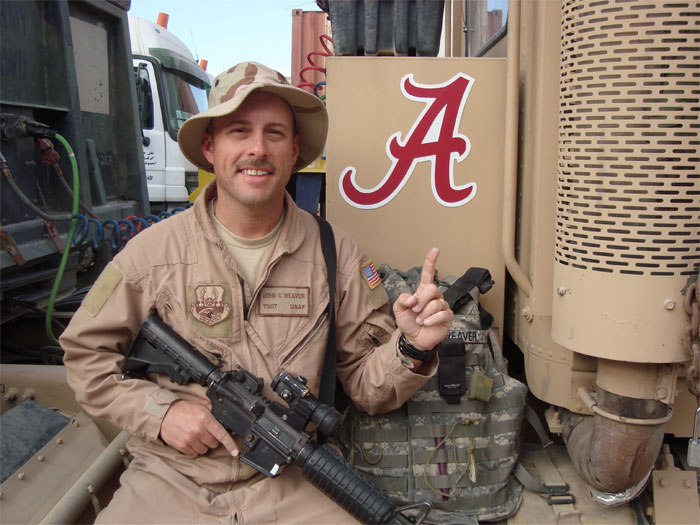 US Air Force Sgt. John Weaver is currently serving in Iraq. Sgt. Weaver is originally from Jay and currently lives in Pensacola with his wife Lisa and three girls, Krista, Randi, and Starla.
US Air Force Sgt. John Weaver is currently serving in Iraq. Sgt. Weaver is originally from Jay and currently lives in Pensacola with his wife Lisa and three girls, Krista, Randi, and Starla.
He and his family are very active and faithful members of Ray’s Chapel, and the family makes the drive several times a week to the church. Over the past several months, the church has continued to support Sgt. Weaver in prayer and with care packages from home.
Pictured top: Ray’s Chapel Baptist Church member Sgt. John Weaver poses in a chair in a former Saddam Hussein palace in Iraq. Pictured middle: Weaver is big Alabama Crimson Tide fan. Pictured below: Weaver (middle) poses with his troop. Submitted photos from Iraq for NorthEscambia.com, click to enlarge.
Spring: March Tips For Your Flowers, Shrubs, Lawn And Garden
March 22, 2009
Now that spring is here and the outdoors are turning green again, it is time to begin thinking about working in your outdoor areas in North Escambia and surrounding areas. From flowers, to tree and shrubs to lawns, the Escambia County Extension Service offers some great tips for the late March through April time period:
Flowers
- Begin planting colorful annual flowers such as ageratum, alyssum, amaranthus, asters, baby’s breath, begonia, calendula, celosia, cosmos, dahlia, dusty miller, gaillardia, geranium, hollyhock, impatiens, marigold, nicotiana, ornamental pepper, pentas, phlox, rudbeckia, salvia, sweet Williams, torenia, verbena, vinca and zinnia.
- Caladium bulbs are extremely sensitive to cold soil so there is no advantage to planting early. Purchase caladiums while there is a good selection, but wait until late March or April before planting them in shady beds.
- Begin watching roses for black spot fungus disease (small black spots on the leaves that quickly worsen). Control it by spraying every seven to ten days with a fungicide. Call your local Extension Office for recommended products.
Trees and Shrubs
- Finish pruning summer flowering shrubs such as althea, hibiscus, abelia, oakleaf hydrangea and oleander.
- Delay pruning azaleas, camellias, spiraeas, gardenias and other spring flowering shrubs until after flowering is complete.
- Prune any cold weather-damaged plants only after new growth appears.
- If needed, fertilize shrubs and small trees with a slow release fertilizer. A good general-purpose landscape fertilizer is a 15-0-15.
- Mature palms should receive an application of granular fertilizer. Use a special palm fertilizer that has an 8-2-12 +4Mg (magnesium) with micronutrients formulation. Apply one pound of fertilizer per 100 sq ft of canopy area or landscape area.
- Pick up all fallen camellia blossoms and remove them from your property. This practice helps to prevent petal blight next season.
- Prune ornamental grasses. For more information visit the online publication, “Considerations for Selection and Use of Ornamental Grasses,” at http://edis.ifas.ufl.edu/EP233 or call you local Extension Office for a copy.
- Evergreen and semi-evergreen trees such as live oak and laurel oak shed most of their leaves during March and early April. Make plans to recycle these leaves on your
property by composting or using them as mulch in vegetable, flower and shrub beds.
Vegetable Garden
- In mid-March, plant vegetables such as bush beans, pole beans, lima beans, cantaloupes, sweet corn, cucumbers, eggplant, okra, southern peas, peppers, sweet potatoes, pumpkins, summer squash, winter squash, tomatoes and watermelon.
- Sweet potato plants (slips/draws) can be set out April through June.
Lawns
- Removing excessive accumulation of leaves from the lawn will increase the effectiveness of fertilizer and pesticide applications.
- If a pre-emergence lawn herbicide is needed to control summer weeds, it should be applied in early March or when day temperatures reach 65 to 70 degrees F for 4 to 5 consecutive days. Make certain to choose one that is safe on your type of grass. Call your local Extension Office for a recommendation.
- Wait until early April to fertilize lawns. If fertilized too early, they often respond with yellow spots of iron chlorosis. Use a slow release nitrogen product with a 3-1-3 ratio
(like a 16-2-16) or a 1:0:1 ratio such as a 15-0-15. - Service the lawn mower by sharpening the blade and adjusting the cutting height for your type of grass.
- Anyone considering establishment of centipede grass from seed should hold off until the soil warms up and stabilizes above 70°F.
- Spring dead spots may be present. Before treating these areas, get a diagnosis. Treat, if necessary, and then patch these areas before weeds invade the bare spots. Sodding, plugging or sprigging helps them to fill in quicker.
Birth: Savannah Leigh Gilmore
March 22, 2009

Benjamin and Rachel Gilmore are proud to announce the birth of their daughter, Savannah Leigh Gilmore. Savannah was born on February 8, 2009 at 12:56 pm and weighed 8 lbs and 10 oz. She is the granddaughter of Glen and Jean Wiggins and Elton and Missy Gilmore and the great granddaughter of Pattie Stone and the late George Stone, Ouida Wiggins and the late Billy Wiggins, and Mattie Lou Sheffield.
NorthEscambia.com is now proud to offer free birth and wedding announcements. For more information, email news@northescambia.com. Announcements will ordinarily appear on our Features page.
Camp Fire Kids Sing In Spring At Century Care Center
March 21, 2009
The first day of spring had some “precious flowers” from Camp Fire USA Day Camp singing for the residents of the Century Care Center. The residents received a handmade piece of artwork and lots of hugs. Submitted photos for NorthEscambia.com, click to enlarge.
1,000 Take Part In Northview FFA Food For America Program (With Photo Gallery)
March 21, 2009
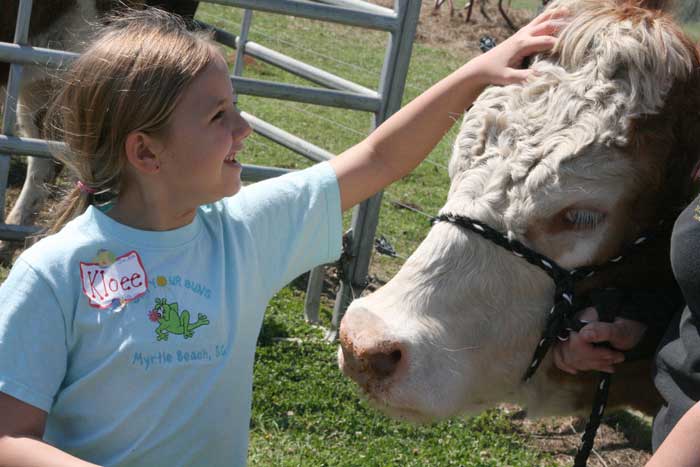 About 800 elementary school students from nine schools attended the annual “Food for America” program Friday at Northview High School , with about 1,000 people total either attending or working with the program.
About 800 elementary school students from nine schools attended the annual “Food for America” program Friday at Northview High School , with about 1,000 people total either attending or working with the program.
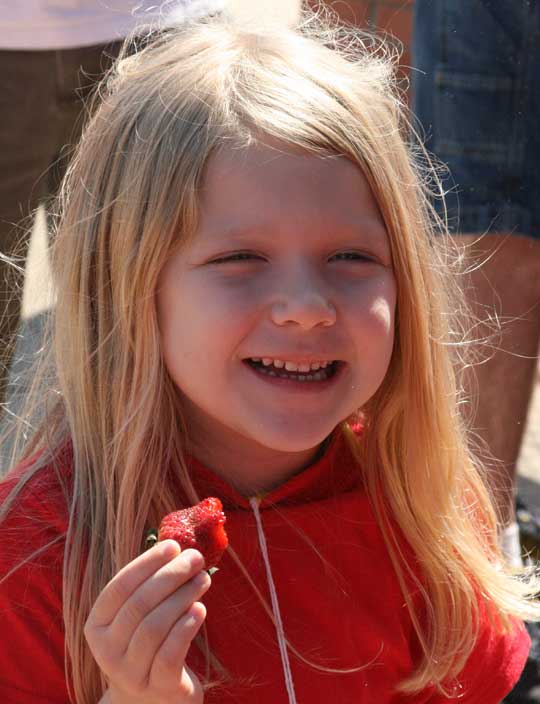 The program, sponsored the National FFA Organization and conducted by the Northview FFA, gave the students a chance to learn about agriculture firsthand as they got up close and personal with farm animals, farm equipment and more. The students even had the opportunity to make their own butter and enjoy it on crackers.
The program, sponsored the National FFA Organization and conducted by the Northview FFA, gave the students a chance to learn about agriculture firsthand as they got up close and personal with farm animals, farm equipment and more. The students even had the opportunity to make their own butter and enjoy it on crackers.
The Northview FFA has participated in the program for 14 years, placing second in the state two years ago. Northview has placed in the top five in the state for the last ten years.
Click here for a complete NorthEscambia.com photo gallery with dozens of pictures from the event.
About 120 FFA students from Northview and Ernest Ward Middle School conducted the program, with about 1,200 people total either attending or working with the program.
Schools scheduled to attend the Food for America program Friday at Northview were Bratt Elementary, Byrneville Elementary, Jim Allen Elementary, Atmore Christian Academy, Jay Elementary, Molino Park Elementary, Century Carver Elementary, Pollard-McCall Elementary, Pensacola Beach Elementary and area home schooled children.
Participants in the FFA’s program included: the Northview FFA, Ernest Ward FFA, North Escambia Beekeepers Association, Escambia River Electrical Cooperative, Young Farmers and Ranchers, Pine Ridge Farms, Florida Division of Forestry, University of Florida-Milton, University of Florida/IFAS Extension, Walnut Hill Volunteer Fire Department, Century Fire Department, Northview 4-H, National Resource Conservation Service, Humane Society, Hendrix Tractor Company, Escambia County Farm Bureau and Stewart’s Grist Mill.
Pictured top: Hundreds of elementary students had the chance to get up close to livestock Friday morning at Northview High School’s annual Food For America program. Pictured middle: Children had the chance to sample fresh strawberries. Pictured below: Students learned about making fresh corn meal. NorthEscambia.com photos, click to enlarge.
A Gator, A Snake And A Turtle Equal Library Fun
March 20, 2009
Flomaton’s Turtle Point Science Center amazed children Thursday afternoon at the Century Branch Library with a collection of small critters. Children had the opportunity to see and touch a snake, turtle and a baby alligator. Next month, the library’s monthly program will feature a much more cuddly creature — the Easter Bunny.
NorthEscambia.com photos, click to enlarge.
Highland Baptist Kids Klub & Undie Sunday Results
March 19, 2009
The Highland Baptist Church Kids Klub presented the results of their Undies Sunday to the Escambia County Farm Bureau Women’s Committee.
Wednesday night, the children presented new underwear, socks and diapers to the women’s committee. The items will presented to the Gulf Coast Kid’s House. The drive at Highland Baptist was organized by Children’s Coordinator Sara Calhoun.
There will also be a donation box at the Molino Farm Bureau office in Molino and Molino Park Elementary School through Monday afternoon.
The Gulf Coast Kid’s House is a center where abused and neglected children receive services from a number of agencies. While the Kid’s House is located in Pensacola and serves all of Escambia County, a fair number of the children served are from our area. Abuse is an issue found in every community, both urban and rural.
For more information, contact Rikki Vidak at 587-4246 or call the Farm Bureau office at 587-2135.
Pictured above: Members of the Kids Klub at Highland Baptist Church presented their Undies Sunday donations for the Gulf Coast Kid’s House during the church’s Wednesday night service. Submitted photo for NorthEscambia.com, click to enlarge.
Were You Ever In 4-H? Tell Your Story
March 16, 2009
The Florida 4-H Youth Development Program is celebrating 100 years of helping young people develop a love of lifelong learning, leadership skills and self confidence.
As part of the celebration, Escambia County is asking former and current 4-H members, parents, volunteers and community partners to share their 4-H experiences in an essay format. “That’s My Florida 4-H Story” may recount a memorable event from your 4-H experience, or highlight a leader, volunteer, agent or parent that made a significant impact on you through 4-H.
Many youth earned significant learning experiences from the 4-H adult volunteers or professionals that guided them on their way. The stories of successful and failed project work in home and farm activities, as well as the leadership skills learned, are the basis for many of the stories 4-H is seeking in “That’s My Florida 4-H Story.”
It may also include experiences gained, activities enjoyed, skills learned and significant relationships developed with peers and adults. Also include basic contact information such as name, address, phone number and the associated 4-H club or program in which you were involved.
With more than 230,000 current members, Florida 4-H is the state’s largest non-formal youth development program. Projects range from aerospace and citizenship to horses and forestry.
Florida 4-H is the youth development program of the Florida Cooperative Extension Service (CES) headquartered in Gainesville within the University of Florida’s Institute of Food and Agricultural Sciences (IFAS). The CES is funded by a partnership between federal, state and county government agencies.
“That’s My Florida 4-H Story” may be sent to the Escambia County Extension Office, 3740 Stefani Rd. Cantonment, FL 32533, or emailed to kdb@ufl.edu by March 18.






